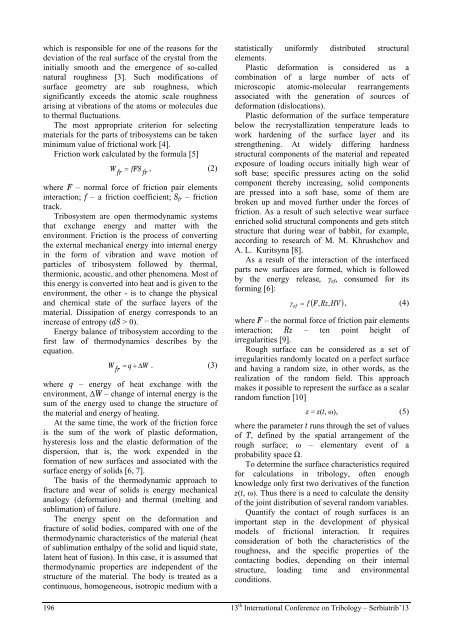Proceedings of SerbiaTrib '13
Proceedings of SerbiaTrib '13
Proceedings of SerbiaTrib '13
- No tags were found...
You also want an ePaper? Increase the reach of your titles
YUMPU automatically turns print PDFs into web optimized ePapers that Google loves.
which is responsible for one <strong>of</strong> the reasons for thedeviation <strong>of</strong> the real surface <strong>of</strong> the crystal from theinitially smooth and the emergence <strong>of</strong> so-callednatural roughness [3]. Such modifications <strong>of</strong>surface geometry are sub roughness, whichsignificantly exceeds the atomic scale roughnessarising at vibrations <strong>of</strong> the atoms or molecules dueto thermal fluctuations.The most appropriate criterion for selectingmaterials for the parts <strong>of</strong> tribosystems can be takenminimum value <strong>of</strong> frictional work [4].Friction work calculated by the formula [5]Wfr fFS , (2)frwhere F – normal force <strong>of</strong> friction pair elementsinteraction; f – a friction coefficient; S fr – frictiontrack.Tribosystem are open thermodynamic systemsthat exchange energy and matter with theenvironment. Friction is the process <strong>of</strong> convertingthe external mechanical energy into internal energyin the form <strong>of</strong> vibration and wave motion <strong>of</strong>particles <strong>of</strong> tribosystem followed by thermal,thermionic, acoustic, and other phenomena. Most <strong>of</strong>this energy is converted into heat and is given to theenvironment, the other - is to change the physicaland chemical state <strong>of</strong> the surface layers <strong>of</strong> thematerial. Dissipation <strong>of</strong> energy corresponds to anincrease <strong>of</strong> entropy (dS > 0).Energy balance <strong>of</strong> tribosystem according to thefirst law <strong>of</strong> thermodynamics describes by theequation.Wfr q W. (3)where q – energy <strong>of</strong> heat exchange with theenvironment, ΔW – change <strong>of</strong> internal energy is thesum <strong>of</strong> the energy used to change the structure <strong>of</strong>the material and energy <strong>of</strong> heating.At the same time, the work <strong>of</strong> the friction forceis the sum <strong>of</strong> the work <strong>of</strong> plastic deformation,hysteresis loss and the elastic deformation <strong>of</strong> thedispersion, that is, the work expended in theformation <strong>of</strong> new surfaces and associated with thesurface energy <strong>of</strong> solids [6, 7].The basis <strong>of</strong> the thermodynamic approach t<strong>of</strong>racture and wear <strong>of</strong> solids is energy mechanicalanalogy (deformation) and thermal (melting andsublimation) <strong>of</strong> failure.The energy spent on the deformation andfracture <strong>of</strong> solid bodies, compared with one <strong>of</strong> thethermodynamic characteristics <strong>of</strong> the material (heat<strong>of</strong> sublimation enthalpy <strong>of</strong> the solid and liquid state,latent heat <strong>of</strong> fusion). In this case, it is assumed thatthermodynamic properties are independent <strong>of</strong> thestructure <strong>of</strong> the material. The body is treated as acontinuous, homogeneous, isotropic medium with astatistically uniformly distributed structuralelements.Plastic deformation is considered as acombination <strong>of</strong> a large number <strong>of</strong> acts <strong>of</strong>microscopic atomic-molecular rearrangementsassociated with the generation <strong>of</strong> sources <strong>of</strong>deformation (dislocations).Plastic deformation <strong>of</strong> the surface temperaturebelow the recrystallization temperature leads towork hardening <strong>of</strong> the surface layer and itsstrengthening. At widely differing hardnessstructural components <strong>of</strong> the material and repeatedexposure <strong>of</strong> loading occurs initially high wear <strong>of</strong>s<strong>of</strong>t base; specific pressures acting on the solidcomponent thereby increasing, solid componentsare pressed into a s<strong>of</strong>t base, some <strong>of</strong> them arebroken up and moved further under the forces <strong>of</strong>friction. As a result <strong>of</strong> such selective wear surfaceenriched solid structural components and gets stitchstructure that during wear <strong>of</strong> babbit, for example,according to research <strong>of</strong> M. M. Khrushchov andA. L. Kuritsyna [8].As a result <strong>of</strong> the interaction <strong>of</strong> the interfacedparts new surfaces are formed, which is followedby the energy release, γ ef , consumed for itsforming [6]: f F,Rz HV , (4)ef ,where F – the normal force <strong>of</strong> friction pair elementsinteraction; Rz – ten point height <strong>of</strong>irregularities [9].Rough surface can be considered as a set <strong>of</strong>irregularities randomly located on a perfect surfaceand having a random size, in other words, as therealization <strong>of</strong> the random field. This approachmakes it possible to represent the surface as a scalarrandom function [10]z = z(t, ω), (5)where the parameter t runs through the set <strong>of</strong> values<strong>of</strong> T, defined by the spatial arrangement <strong>of</strong> therough surface; ω – elementary event <strong>of</strong> aprobability space Ω.To determine the surface characteristics requiredfor calculations in tribology, <strong>of</strong>ten enoughknowledge only first two derivatives <strong>of</strong> the functionz(t, ω). Thus there is a need to calculate the density<strong>of</strong> the joint distribution <strong>of</strong> several random variables.Quantify the contact <strong>of</strong> rough surfaces is animportant step in the development <strong>of</strong> physicalmodels <strong>of</strong> frictional interaction. It requiresconsideration <strong>of</strong> both the characteristics <strong>of</strong> theroughness, and the specific properties <strong>of</strong> thecontacting bodies, depending on their internalstructure, loading time and environmentalconditions.196 13 th International Conference on Tribology – Serbiatrib’13
















